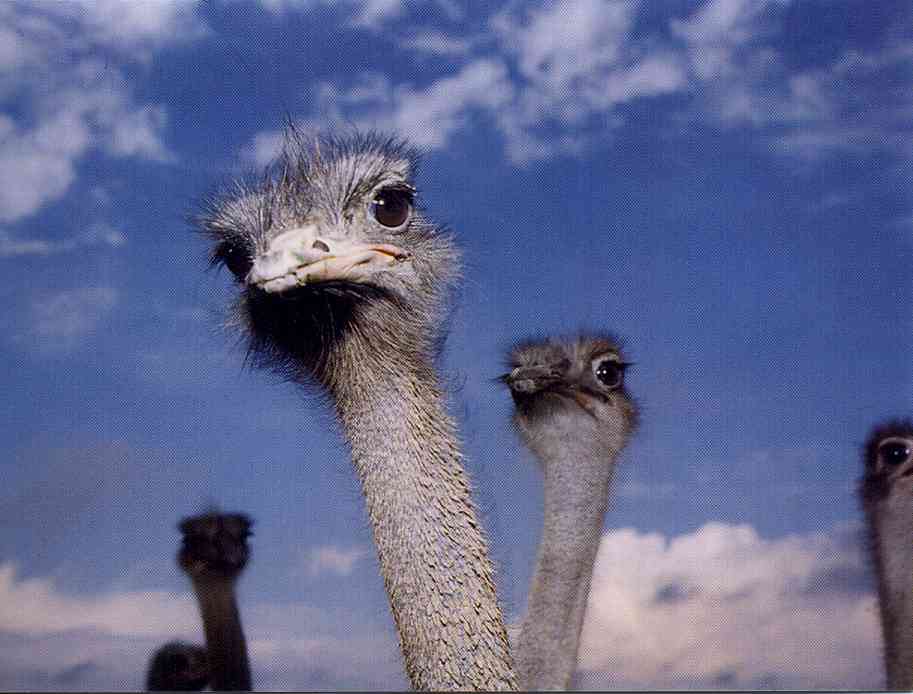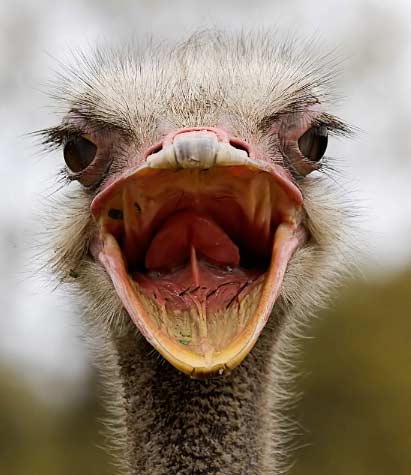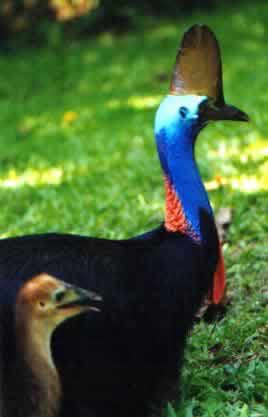Ostrich, Emu, Cassowary
Wait A Minute!! You Like Me for My What?!?My father told me all about the birds and the bees, the liar - I went steady with a woodpecker till I was twenty-one. - Bob Hope
Source: © Lindwood Farm, Incorporated, 400 Glenmeade Road, Greensburg, Pennsylvania 15601, 1 (800) 274-3263 This card was mailed to me by Ostrim, a company that makes ostrich sticks - like beef sticks only made with ostrich. Do they really think it helps sales for you to see the faces of the animals you'd be eating?
Revolt!
Who Says I Can't Fly?
Click to Play
Amorous Emu Fails to Get Her ManMobile, Alabama - A 6-foot-tall, 150-pound emu that fell head over heels in love with an Alabama man and stalked him for days was turned loose Thursday on a farm populated by her own species. "It was mating season and she took a fond liking to him," Diane Roberts, director of the Mobile, Alabama, Animal Rescue Foundation, told Reuters. "He had to ward her off with a boat paddle. She was absolutely intent that this was her mate." The giant bird showed up at the home of Ed and Ann Stuardi last month, drinking from a birdbath and eating berries in their yard. They fed it dog food. Last week the emu began following Ed Stuardi around. Then it became aggressive, chasing their cats. Stuardi tried to frighten the bird away by shooting his gun into the air. The emu just stood there, looking at him forlornly. By Monday, it was making noises deep in its throat, a mating call Stuardi failed to recognise as the bird approached him. Shorter than the bird, he held it off with a boat paddle. Monday night and Tuesday, the Stuardis cowered inside their home. Ann Stuardi called the sheriff to beg for help but was told deputies didn't have the equipment to catch the bird. That's when Animal Rescue Foundation got involved. "She pursued him. They had been feeding her, and when mating season hit, he almost got it. She had her heart set on this man," said Roberts. "I've never seen an emu hold hostages," she said. "He wasn't aware what the bird wanted, or why she was stalking him. I've never seen one stalk a human with procreation in mind." Animal Rescue had been looking for the bird since Aug. 22, when it heard that a man had moved away from the area, abandoning three emus. The other two birds still have not been found. It took several hours for the rescue team to persuade the bird to get into a horse trailer so it could be taken to a farm that cares for injured wildlife. Roberts said the emu's only injury was a broken heart, and it was released into an area with other emus, including several males. "Hopefully she will meet another fellow and forget all about Mr Stuardi. After all, he is a married man," Roberts said. Source: Reuters Thursday October 22 1999
This Emu Got HersA man walks up to the bar with an emu behind him. As he sits down, the bartender comes over and asks for their order. The man says, "I'll have a beer." He turns to the emu and asks, "What's yours?" "I'll have a beer too," says the emu. The bartender pours the beer and says, "That will be $3.40 please." The man reaches into his pocket and pulls out the exact change for payment. The next day, the man and the emu come in again, and the man says, "I'll have a beer," and the emu says, "I'll have the same." Once again the man reaches into his pocket and pays with the exact change. This becomes a routine until, late one evening, the two enter again. "The usual?" asks the bartender. "Well, it's close to last call, so I'll have a large scotch," says the man. "Same for me," says the emu. "That will be $7.20," says the bartender. Once again the man pulls exact change out of his pocket and places it on the bar. The bartender can't hold back his curiosity any longer. "Excuse me sir, how do you manage to always come up with the exact change out of your pocket every time?" he asks. "Well," says the man, "Several years ago I was cleaning the attic and found an old lamp. When I rubbed it a Genie appeared and offered me two wishes. My first wish was that if I ever had to pay for anything, I just put my hand in my pocket, and the right amount of money will always be there." "That's brilliant!" says the bartender, "Most people would wish for a million dollars or something, but you'll always be as rich as you want for as long as you live!" "That's right! Whether it's a gallon of milk or a Rolls Royce, the exact money is always there," says the man. The bartender asks, "One other thing, sir, what's with the emu?" The man replies, "My second wish was for a chick with long legs..."
Is he lucky he didn't get a cassowary instead? Cassowary: Friend or Foe?
The Kuranda area of far north Queensland is a key zone for the endangered Cassowary, the birds around Cassowary House have raised 7 chicks since June 1998, with another male a couple of kilometres along the same road having a similar record and currently having 4 chicks. In January 2002 we had a new female appear, and occasionally join with the family group, though the regular female soon drives her away when they coincide here. The individual birds are readily recognisable by their casque shapes and patterns, with males having a drooping bustle and females being considerably larger and having a more pear shaped rear end. Major threats here include uncontrolled dogs wandering in the state forest, feral pigs destroying the nests, and above all else road traffic. Our dirt road has a 40 km/h speed limit, which is often ignored, and requests for traffic calming bumps have met with disinterest from the Shire Council, an often unsympathetic one where the environment is concerned. One official from the Queensland State Forests Department actually told us that we couldn’t have speed bumps because people drive too fast - go figure. I think it’s all to do with the dreaded liability issue. The Kuranda area is undoubtedly once of the best places to see the charismatic birds, easily as good as the well-known Mission Beach where the traffic issue is a similar problem. They had 4 birds killed on their roads in 2001, whilst we lost one late in 2000 to a road gravel lorry, with another hit and not accounted for. It is clearly time to raise the profile for this bird, which could easily be the flagship charismatic megafauna species for a major ecotourism and conservation initiative. Sadly, the Cassowary Conservation Liaison Officer appointed when the species was declared endangered in late 2000 was only a temporary appointment, funded for a few months to tie in with the new conservation status, but then abandoned. Source: cassowary-house.com.au
Southern Cassowary (Casuarius casuarius) 200 cm
Breeding
Additional Information
Some Ways to Help
Source: rainforest-australia.com/cassowary
For more on animals, including reptiles, crustaceans, arachnids, insects, fish, birds, pets, livestock, rodents, bears, primates, whales and Wellington's waterfront, click "Up"
below to take you to the Table of Contents for this Animals section. |
 Animals
Animals Animation
Animation Art of Playing Cards
Art of Playing Cards Drugs
Drugs Education
Education Environment
Environment Flying
Flying History
History Humour
Humour Immigration
Immigration Info/Tech
Info/Tech Intellectual/Entertaining
Intellectual/Entertaining Lifestyles
Lifestyles Men
Men Money/Politics/Law
Money/Politics/Law New Jersey
New Jersey Odds and Oddities
Odds and Oddities Older & Under
Older & Under Photography
Photography Prisons
Prisons Relationships
Relationships Science
Science Social/Cultural
Social/Cultural Terrorism
Terrorism Wellington
Wellington Working
Working Zero Return Investment
Zero Return Investment

